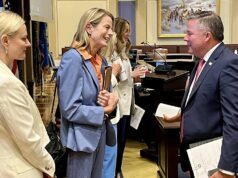

It would have been a mistake to follow through with an initial plan to abruptly close North Highland Elementary School without taking time to consult with the community or to make plans. To her credit, Superintendent Aurora Lora has backed off from that approach.
Also to its credit, the current OKCPS administration now acknowledges the need for wraparound services. In announcing a change to its plans after the school was burglarized and vandalized Friday night, the administration explained,
… district teams will work to staff the building with additional supports including an extra assistant principal, full-time counselor, and two social workers, all of which were allocated to North Highland prior to the consideration of a temporary closure.

North Highland problems in 2012 led to brief closure
In 2012, then-Oklahoman reporter (and current school board member) Carrie Coppernoll covered the brief closure of the school to discuss its rampant disorder. OKCPS said that half of the faculty was new, but turnover was a long-standing problem. It admitted, “Sometimes we may Band-Aid something when really we need a full 9-1-1 effort,”
The district pledged to get to the roots of the situation. Instead, it focused on the easy “areas of teacher training, including behavior, [and] classroom management.”
Segregation by any other name …
Many of the problems facing today’s North Highland neighborhood can be traced to the way the Oklahoma Industries Authority conducted urban renewal, wrecking a proud African-American community and the way that families were relocated to the Highland.
For unnerving accounts of how urban renewal created the same destruction across the nation, read the works of Richard Kahlenberg and Ta-Nehisi Coates. They make a strong case that the segregation of the Highland and similar neighborhoods are the legacies of de jure segregation, or segregation by law. Then de facto segregation and the “Big Sort,” or separation by choice, produced a neighborhood that was one of Oklahoma City’s 13 census tracts characterized by the Brookings Institution as “extreme poverty.” Today, the poverty rate is greater than 45 percent.
Sincere but impatient policymakers fall short
The OKCPS still accepts the incomprehensible situation where North Highland is staffed with the same formula as Nichols Hills Elementary School. Refusing to face facts about what it would really take to turn around the North Highland Park neighborhood and the school it feeds, Centennial, they’ve gone along with the normative approach: cheap and easy quick fixes, one after another.
The most destructive silver bullets were the over-proliferation of charters and high-stakes testing. By increasing segregation and by driving so much of the joy of learning out of inner-city classrooms, school “reform” made it virtually impossible to keep high-quality teachers or to fund the socio-emotional supports that high-challenge schools need.
Local policy makers, like their national counterparts, have been sincere but impatient. Many or most of the old urban renewal social engineers also were sincere, believing they had to destroy neighborhoods to save them. Today’s school reformers have rushed to judgment, assuming that only school closures are fast enough to save kids.
Sadly, the Oklahoma City Public Schools system has a long history of refusing to engage in conversations about what it would really take to turn around schools in neighborhoods with intense concentrations of children from generational poverty, many of whom have endured multiple adverse childhood experiences. To mention the effects of trauma was to open an educator up to the charge of making excuses and putting “adult interests” over “whatever it takes” to “put kids first.”

Conversations lead to lessons
The last time I brought a pecan pie to the grieving grandmother of a former student almost a decade ago, I surveyed North Highland Park and the surrounding homes. I stood in the front yard and took inventory of my students who had been injured or murdered — or who had killed someone else. The Bloods weren’t on duty on the northeast part of the park, but new graffiti was across the street.
I also recalled dozens of conversations my deceased student and I had enjoyed as I would drive him home after our pickup basketball games. They had been just as rewarding as hundreds of discussions in the living rooms and driveways of other students, where we kept talking through those kids’ fears and dreams.
During this year’s school board-election campaign, I was campaigning for Stanley Hupfeld for board chairman and Rebecca Budd to represent District 2, which includes the Highland. In the course of the campaign, I engaged in many more conversations with former students as well as the large numbers of kids who informally transfer to other schools or attend magnets and charters. Often, I was unable to stop myself, and the results were ad hoc lessons about current events like the ones my students and I loved to discuss.
‘A teacher just gotta teach’
In the 1980s, voter turnout was so low in the Highland that Jesse Jackson campaigns didn’t bother to leaflet the area. Later, the Obama campaign also had reservations regarding my insistence about doing so. The day after I canvassed the neighborhood in 2008, my John Marshall students asked me why I’d talked for so long with the Bloods in the park, and what we were talking about.
I answered that we had been discussing the same lessons that we shared in class. The Bloods were just as interested in meaningful conversations about “History in the News” as other students were at school. The class teased me, saying I couldn’t help myself; “a teacher just gotta teach.”
The same applies to the kids in the Highland; students “just gotta learn.” And they will when we invest whatever it takes to create safe, orderly, respectful and loving learning environments that allow for meaningful instruction and learning.




















